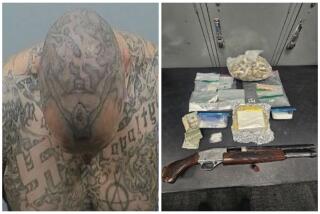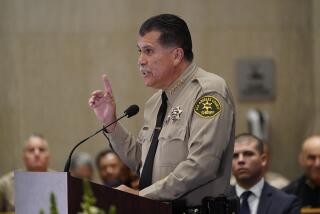Dozens arrested in crackdown on Latino gang accused of targeting blacks
- Share via
Federal authorities Thursday accused a south Los Angeles County street gang of a litany of crimes, including the murder of a sheriff’s deputy and racially motivated attacks designed to drive African Americans from their town.
The charges, part of a massive racketeering case dubbed Operation Knock Out, were outlined in several indictments charging 147 members and associates of the Varrio Hawaiian Gardens gang with murder, attempted murder, drug trafficking, weapons trafficking, extortion, kidnapping and witness intimidation.
The gang, also known as VHG, is so pervasive in Hawaiian Gardens that one in 15 people living in the square-mile city just north of Long Beach has ties to it, said Sal Hernandez, the FBI’s top agent in Los Angeles.
“Imagine living in a community where one in every 15 of your neighbors swears allegiance to an organization committed to the spread of violence,” he said. “The good people deserve to live in peace.”
The early morning raids Thursday involved approximately 1,400 local, state and federal law enforcement officers who fanned out across the small, densely populated city and surrounding communities. Seventeen SWAT teams helped make the arrests.
The probe into the gang began in 2005 after Los Angeles County Sheriff’s Deputy Jerry Ortiz was fatally shot by a Varrio Hawaiian Gardens gang member he was trying to arrest in connection with the shooting of an African American man. The shooter, a veteran gang member with devil’s horns tattooed on his forehead, has been convicted of murder and sentenced to death.
U.S. Atty. Thomas P. O’Brien, speaking at a news conference at the Lakewood sheriff’s station, where the slain deputy had been assigned, touted the case as the “largest gang takedown in United States history.”
“Today we honor Deputy Ortiz by coming together to crush the outlaw gang that took his life and make a positive difference for the law-abiding people who live in Hawaiian Gardens,” said O’Brien, who stood in front of a memorial to Ortiz and other officers killed in the line of duty as he spoke.
Authorities said the gang was formed in the 1950s or early ‘60s and today has more than 1,000 members spanning several generations, many of them with connections to the Mexican Mafia.
The gang started out with street robberies, drug dealing and turf wars with other gangs, but has since escalated its level of violence, authorities allege.
It is accused of taunting law enforcement with particularly brazen acts, including scrawling “187,” the California Penal Code designation for homicide, on a sheriff’s patrol car in 2006. Authorities interpreted the vandalism as a reference to Ortiz’s killing a year earlier.
Gang members also spray-painted the words “Rest in Piss Ortiz” on a wall, said Assistant U.S. Atty. Michael S. Lowe, the lead prosecutor on the case.
The gang members, with monikers such as Slasher, Shady, Diablo and Menace, boasted about being racist, referring to themselves as “the Hate Gang,” according to a 193-page indictment that outlines the racketeering case.
“VHG gang members have expressed a desire to rid the city of Hawaiian Gardens of all African Americans and have engaged in a systematic effort to achieve that result by perpetrating crimes” against them, the document states.
The indictment details 476 “overt acts” that gang members allegedly committed as part of the racketeering conspiracy since 1992. The crimes include the dealing of methamphetamine, heroin and crack, and the killing of a fellow gang member suspected of cooperating with law enforcement.
The document also details more than a dozen incidents in which African Americans were allegedly beaten, shot at or harassed because of their race.
In one incident, a gang member is accused of using a racial epithet against an African American, yelling at him to “get out of town,” then attacking him with a garden rake. The indictment states that one gang member was heard bragging about the murder of Ortiz, saying it had put the gang “back on the map.”
As a result of the raids Thursday, about 90 suspected gang members and associates were arrested, including some who were not listed in the indictment but taken into custody for other alleged crimes, authorities said.
Thirty-five of those charged were already in custody for other alleged crimes; 49 either remain at large or have yet to be identified.
During the four-year probe, authorities seized 105 guns and more than 30 pounds of methamphetamine, cocaine and heroin. The drugs had an estimated street value “worth well over a million dollars,” said Timothy J. Landrum, special agent in charge of the Drug Enforcement Administration in Los Angeles.
Dozens of the defendants made their initial appearances in U.S. District Court in Los Angeles, where most were ordered held without bail.
Thom Mrozek, a spokesman for the U.S. attorney’s office, said the number of defendants charged in the case significantly exceeded the 102 defendants charged in a case against the Florencia 13 gang two years ago -- a case prosecutors then said was the biggest of its kind in the nation.
Reaction to Thursday’s raids varied.
Hawaiian Gardens Mayor Michael Gomez praised authorities, saying “the city appreciates the help, both in resources and personnel that we have received in today’s anti-gang operation.
“Honest residents should not have to live in fear of lawless thugs who act like its high noon at the OK Corral.”
Barry Bruce, a community activist who took it upon himself to attend the news conference at which the arrests were announced, accused authorities of overstating the gang problem in Hawaiian Gardens and of mistreating residents he said were falsely labeled as gang members.
“There are serious violations of civil rights going on in the community,” Bruce, who runs an urban outreach program called Way Out Ministries, told reporters. “The police are supposed to follow the law.”
--
More to Read
Sign up for Essential California
The most important California stories and recommendations in your inbox every morning.
You may occasionally receive promotional content from the Los Angeles Times.












